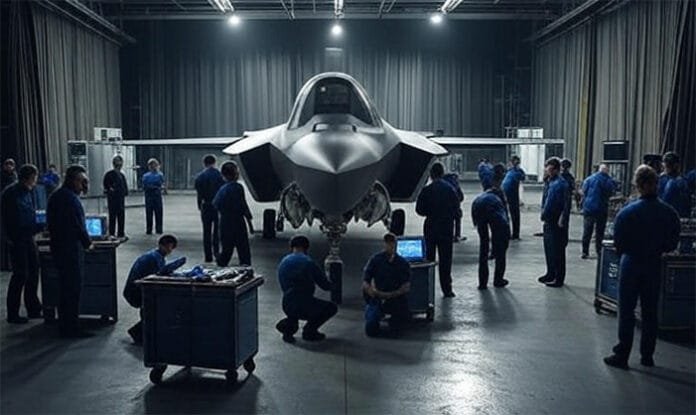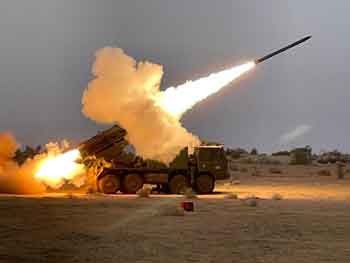The British F-35B Lightning II fighter jet, which has been grounded at Thiruvananthapuram International Airport since June 14, has now entered a critical repair phase. The fifth-generation stealth aircraft, renowned for its vertical landing capabilities and multi-role combat features, was moved into a curtain-covered hangar, where British and American aviation engineers are engaged in intricate technical restoration. This development has garnered intense attention from defense analysts, aviation experts, and media outlets across the globe.
Top-Security Hangar Enclosure for Sensitive Repairs
As soon as the combined team of British aerospace engineers and Lockheed Martin specialists from the United States arrived in Kerala on Sunday, their first move was to carefully relocate the jet into a specialized hangar at the terminal facility. The entire operation was carried out under tight security measures, ensuring zero exposure to the public or unauthorized personnel. The hangar has been completely draped with thick curtains, shielding the fighter jet from any photographic or videographic surveillance. This visual blockade is reportedly aimed at protecting the sensitive design of the F-35’s stealth features, sensor arrays, and electronic warfare equipment from external scrutiny.
Controlled Environment: Temperature-Regulated Hangar for Precision Work
The entire hangar has now been transformed into a climate-controlled environment, complete with industrial-grade air conditioning systems to maintain a stable, low-temperature atmosphere. Experts suggest that the cool environment is essential for high-precision tasks involving avionics, fiber optics, and thermal-sensitive components embedded within the F-35’s electronic core. The technical crew is believed to be focusing on diagnostics using advanced portable instruments that require accurate thermal stability for optimal performance.
Fault Diagnostics Underway: Experts from Lockheed Martin and UK Defense
Sources close to the operation report that the issue is suspected to be rooted in the aircraft’s onboard computing or propulsion subsystem, although official confirmation has yet to be released. Lockheed Martin engineers, who manufacture the F-35 Lightning II, are working closely with personnel from the UK Ministry of Defence (MOD) and Royal Air Force (RAF) to run a comprehensive multi-point inspection. The complexity of the F-35’s internal architecture requires synchronization between software diagnostics and physical inspection of key structural systems, including:
Electro-optical targeting system (EOTS)
Pratt & Whitney F135 engine
Flight control actuators
Mission data files and sensor fusion core
Distributed aperture system (DAS)
These components are individually tested for operational health and synchronization, especially after long intercontinental flights that may trigger sensor or pressure anomalies.
F-35B’s Arrival and Parking at Kerala Airport: What We Know
The F-35B Lightning II was reportedly en route as part of a joint exercise or air defense demonstration, potentially linked to UK-India military collaborations. However, after a mid-flight alert indicating a technical malfunction, the aircraft made a precautionary landing at Thiruvananthapuram International Airport, where it has remained parked since June 14.
Eyewitnesses initially spotted the jet being towed to a remote bay, cordoned off with security personnel and ground crew, wearing markings indicative of Royal Air Force operations. Since then, there has been no public communication from MOD UK, Lockheed Martin, or Indian authorities regarding the precise nature of the malfunction.
High-Level International Collaboration Behind the Repairs
The current repairs underscore the level of international coordination required to maintain a sophisticated aircraft like the F-35. With over 300,000 individual parts, many of which are connected to real-time monitoring systems, the F-35 cannot be serviced using conventional airbase facilities. The UK has reportedly flown in classified technical manuals, diagnostic toolkits, and encrypted software required to interface with the jet’s digital cockpit systems.
In addition, Indian aviation authorities have reportedly facilitated temporary clearances for the engineering team, ensuring uninterrupted access to tools and materials. Civil Aviation Security protocols have been heightened around the hangar zone, including temporary no-drone zones and deployment of surveillance jammers.
Logistical Complexity: Transporting Repair Modules and Equipment
Aircraft as technologically advanced as the F-35B often require customized spare parts, tools, and encrypted software interfaces to troubleshoot internal problems. In this case, repair logistics were reportedly managed by RAF’s Expeditionary Air Wing with coordination from Lockheed Martin’s Rapid Response Logistics Division.
High-security containers carrying modular diagnostic terminals, replacement circuits, and mission software patches arrived on military-chartered cargo flights, which were parked at a separate tarmac strip in Kerala. These shipments have been kept under armed surveillance since arrival.
Why the Curtains? Beyond Secrecy, a Tactical Necessity
While curtaining the hangar may seem like an overly cautious move, it is in fact a standard operating procedure for fighter jets undergoing internal hardware or stealth-related inspections. It prevents:
Exposure of stealth coating layers to atmospheric elements
Optical espionage or sensor data mapping by adversaries
Unauthorized access to specialized components under repair
It also helps maintain lighting control, which is crucial when dealing with infrared or laser-based calibration tools used to align mission-critical systems.
Implications for Indo-British Military Ties
Although this incident was unplanned, the level of coordination between Indian authorities, the British High Commission, and Lockheed Martin reflects a mature defense relationship between India, the UK, and allied defense manufacturers. It demonstrates the strategic trust placed in India to host and assist the repair of one of the world’s most advanced fifth-generation fighters, even in the absence of prior deployment protocols.
Analysts suggest this event could pave the way for:
Future joint air exercises between the Royal Air Force and Indian Air Force
Defense collaboration in areas like stealth systems, next-gen avionics, and airbase interoperability
Establishment of interim repair depots for allied forces in India
What Happens Next? Ongoing Monitoring and Clearance Procedures
The repair timeline remains undisclosed, though industry insiders suggest the aircraft may remain at the Thiruvananthapuram airbase for several more days, depending on the availability of spares and the complexity of detected issues. Once the technical team completes the diagnostics and re-certification process, the jet will undergo:
Ground engine tests
Avionics system reboot
Short vertical takeoff and hover checks
Permission from airspace regulators for onward flight
Conclusion: A Rare Glimpse into Modern Military Maintenance
The presence of the British F-35B stealth jet in India offers a rare behind-the-scenes look into the sophisticated and closely guarded maintenance procedures that modern fighter aircraft demand. With elite engineers, classified diagnostic equipment, and airtight security protocols, the operation at Thiruvananthapuram International Airport serves as a quiet but powerful testament to the intricacies of modern aerial warfare readiness and international defense collaboration.
















